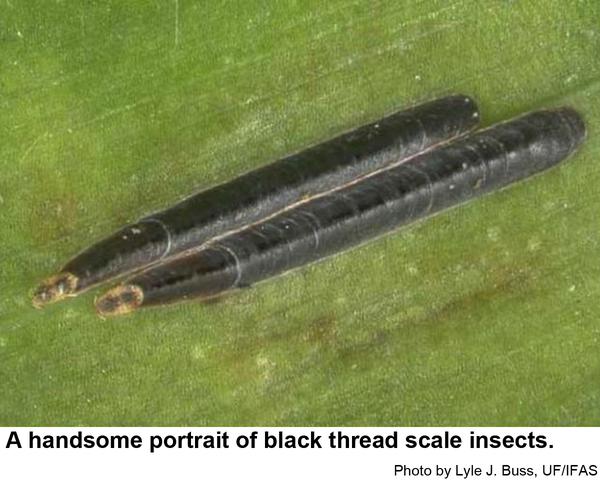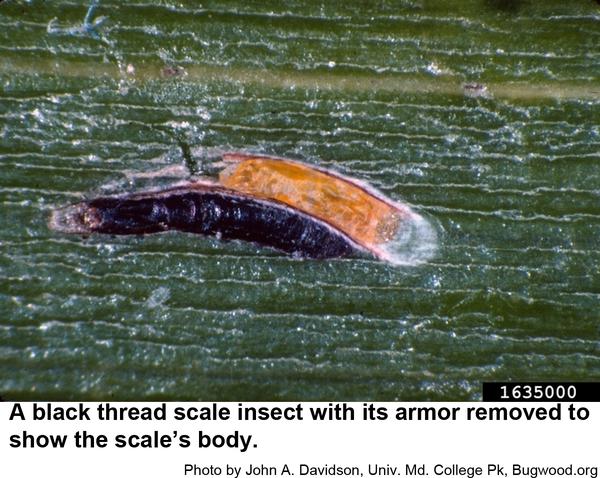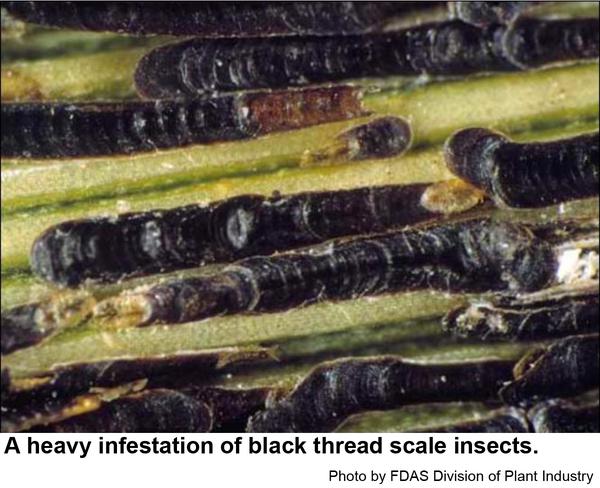Description and Biology
Black thread scale, Ischnaspis longirostris, is one of the armored scale insects that secrete a test (the "armor") inside of which these insects grow and reproduce. The test protects armored scales from many parasites and predators as well as weather. The test also protects armored scales from some pesticides. Black thread scales secrete a black, slender, elongate armor up to 3/16 inch long as they develop. Their armor is whitish and papery underneath the scales. Females lay 20 to 30 eggs under their armor that soon hatch. Tiny crawlers emerge from under the armor and crawl about and within 24 hours settle down to insert their thread-like mouthparts to feed on fronds, petioles, and fruit. Black thread scales tend to develop parallel to leaf veins. Once settled down, female insects do not change locations again. Development takes about a month.
Host Plants
Black thread scale infests palms and Swiss cheese plants in Florida where it is occasionally a very serious pest on greenhouse floriculture crops as well as tropical fruit trees outdoors. It has been collected from at least 50 plant families and 130 genera.
Residential Recommendations
Scale insects have predators, parasites, and diseases that help suppress scale populations, particularly in the long term. Ladybird beetles are somewhat effective in controlling the black thread scale. Other reported natural enemies include tiny parasitic wasps. If the population gets too numerous, armored scales are susceptible to horticultural oils. These oils pose little threat to the environment or people and animals when they are diluted properly for sprayed according to directions found on their labels. Probably 18 different brands of horticultural oils are on the market. Although they are essentially the same chemical, rates for application on the labels vary significantly. During the growing season, it would be well to use not more than the 2% rate to prevent damage to the plants (5 tablespoons of oil per gallon of water). Plants should be well irrigated before treating them to prevent pesticide injury.
Other Resources
- Armored Scale Identification and Management on Ornamental Plants. Frank, S. 2010. Entomology Insect Notes, NC State Extension Publications.
- Black Thread Scale, Ischnaspis longirostris (Signoret) (Insecta: Hemiptera: Diaspididae). Espinosa, A. et al. 2019 (reviewed). University of Florida IFAS Extension, Solutions for Your Life.
- Florida Armored Scale Insects. Dekle, G. W. 1965. Arthropods of Florida and Neighboring Land Areas, Vol 3. 265 pp.
- Armored Scale Insect Pests of Trees and Shrubs (Hemiptera: Diaspididae). Miller, D. R. and J. A. Davidson. 2005. Cornell University Press. Ithaca, NY. 456 pp.
- Horticultural Oils for Ornamental Plants. Frank, S. et al. 2018. Entomology Insect Notes, NC State Extension Publications.
- NC State Extension Plant Pathology Publications
- NC State Horticultural Science Publications
- North Carolina Agricultural Chemicals Manual
For assistance with a specific problem, contact your local Cooperative Extension center.
This factsheet has not been peer reviewed.
Publication date: July 13, 2020
Reviewed/Revised: May 8, 2025
Recommendations for the use of agricultural chemicals are included in this publication as a convenience to the reader. The use of brand names and any mention or listing of commercial products or services in this publication does not imply endorsement by NC State University or N.C. A&T State University nor discrimination against similar products or services not mentioned. Individuals who use agricultural chemicals are responsible for ensuring that the intended use complies with current regulations and conforms to the product label. Be sure to obtain current information about usage regulations and examine a current product label before applying any chemical. For assistance, contact your local N.C. Cooperative Extension county center.
N.C. Cooperative Extension prohibits discrimination and harassment regardless of age, color, disability, family and marital status, gender identity, national origin, political beliefs, race, religion, sex (including pregnancy), sexual orientation and veteran status.



